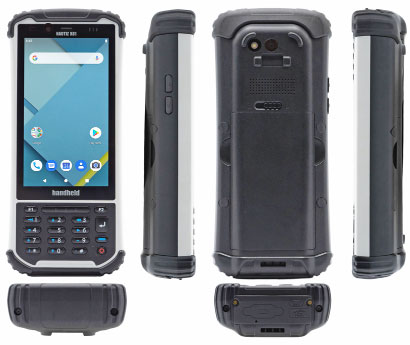On September 28, 2022, the Handheld Group introduced the Nautiz X81, the latest member of the company's line of rugged handheld computers that also includes the Nautiz X2, X41, X6, and X9. The new Nautiz X81 joins the existing Nautiz X41 in offering a physical keypad in addition to touch, as well as 5G connectivity and nearly limitless customization capability via an expansion cap system that allows for a wide array of affordable and easy-to-develop solutions.

As is immediately obvious from the picture above, the Nautiz X81 sports a purposeful industrial design with an integrated physical keypad and the Handheld Group's distinct light-gray/black color scheme, neatly and optimally merging form, brand and function. The new handheld's display measures 4.8 inches diagonally, nice and big for an ergonomic handheld that also includes a full physical keypad. The lineup below shows how the new Nautiz X81 compares to Handheld's full lineup of Nautiz models as of October 2022:

To put the size in perspective, the Nautiz X81 measures 7.5 x 3.1 inches, is 1.3 inches thick, and weighs just over a pound. That's a footprint as wide as a modern big-screen smartphone but maybe an inch taller.
Now if you look at the news Nautiz X81 and think that it kinda, sorta reminds you of something else you've seen from Handheld, you're not wrong. The Nautiz X81 channels the old Nautiz X8 very, very closely. From the outside. Inside, not. There it's all new. Handheld freely admits that in its press release. When the company surveyed customers, they wanted an all-new set of specs but really liked the old look and form factor. And for good reason.
That's because the original version of the Nautiz X8, introduced almost exactly eight years ago, was caught smack between the trailing end of the old and dying Microsoft Windows Mobile and the up-and-coming Android. Windows Embedded Handheld 6.5, as Microsoft called it, was still hanging in there, the last of Microsoft's once industry-leading mini OS, and so at the time it still made sense for Handheld to offer it. But the times, they were a-changin, and so the first Nautiz X8 was also available with Android, version 4.2.2. That was made possible via one of Texas Instruments' OMAP processors that could run both. That made sense, because back in 2014 the Microsoft vs Android battle hadn't been decided yet.
It's very much decided now and has been for several years. And resurrecting the really excellent design and functionality of the original Nautiz X8 as a native Android device with all the latest Android tech made perfect sense. So the new Nautiz X81 may look almost exactly the same as the old Nautiz X8, but inside it's a completely new machine, a true modern industrial handheld. One based on a modern ARM-optimized MediaTek chip, running Android 12 GMS. One with four times the RAM as the original Nautiz X8, 16 times the onboard storage, much higher resolution cameras, a micro SDXC card slot that can handle cards with much more storage, much faster WiFi, much faster Bluetooth, 4G LTE and 5G mobile broadband, multi-band dedicated GNSS and, of course, USB Type A and a USB Type-C port.
Staying with the beloved older form factor did mean staying with roughly the same display size. Back in 2014, the 4.7-inch Nautiz X8 was big, but in 2022 the new 4.8-inch screen doesn't feel that big anymore next to all those huge smartphone screens. It's much sharper, though; its 720 x 1280 pixel resolution making for 306 pixels per inch (the X8 had only 210 ppi). The initial specs don't include a nits screen brightness rating, but Handheld's press release mentions a "unique display technology" for a sunlight-readable screen that doesn't quickly drain the battery (which now has more capacity).

Unlike most modern-era handhelds, the Nautiz X81 still has the physical keypad. That's because there remain many tasks where a physical pad with its precision and tactile feedback remains preferable. A lot of customers will love it. Sometimes nothing else will do. There's also a dedicated scan button for use with the optional integrated barcode scanner.
The X81 is also a major step up in the camera department. The rear-facing 13.0-megapixel autofocus camera with LED flash should be plenty good enough for most documentation purposes, and there is now a 5-megapixel front-facing camera as well.
Unsurprisingly, the Nautiz X81 is as tough and rugged and built to survive on the job as the original Nauiz X8, and likely even a bit more so. The unit carries full IP67 sealing where the "6" means it's totally dustproof, and the "7" that it can handle full immersion down to about three feet. This means it'll survive even an accidental drop into stream. The operating temperature range is a very wide -22 to 140° Fahrenheit (-30 to 60° Celsius), which means it can be used anywhere. The Nautiz X81 can also handle repeated drops from five feet (up from four), and has been MIL-STD-810G tested for a variety of other ruggedness criteria.
Overall, repurposing the old Nautiz X8's form factor and design with state-of-the-art Android functionality and technology makes perfect sense. This is not just an upgrade. For all practical purposes, the Nautiz X81 is an entirely new, modern Android device built on the size, ergonomics and the choice of user interface -- touch and/or keypad -- of a platform that was already perfect for the job. — C. Blickenstorfer, September 2022







